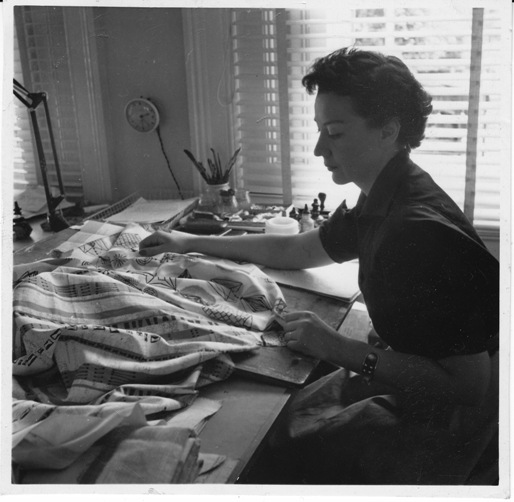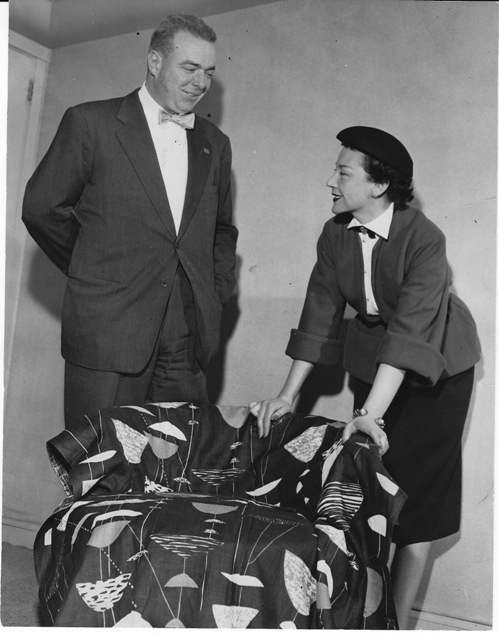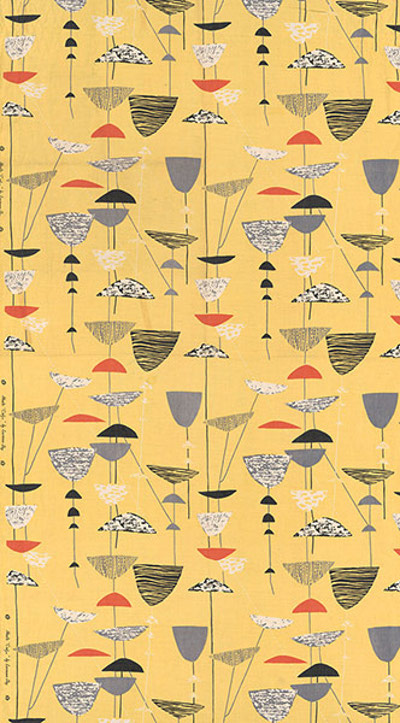
Lucienne Day at her drawing board. Copyright Robin and Lucienne Day Foundation
British textile designer Lucienne Day, with her signature geometric designs and splashes of colour, is a huge source of inspiration for me when I approach a new interior design commission. She had a profound effect on pattern design during the 1950s and 60s and her influence is still seen in today’s modern room designs. Andrew Casey’s recently released 248-page book dedicated to the life and designs of Lucienne Day, and it’s a really good read. He has brought her work back into the limelight and highlights her influence on today’s interior design industry which is shown to be both obvious and subtle.

Lucienne Day showing her ‘Calyx’ print to an unidentified gentleman. Copyright Robin and Lucienne Day Foundation
Beautiful Designs within a Beautiful Book
‘Lucienne Day: In The Spirit of the Age’ by Andrew Casey is a beautifully illustrated and comprehensive overview of one of the 20th century’s most influential textile designers. Lucienne Day was considered a pioneer of her time beginning with the appearance of her ‘Calyx’ design at the Festival of Britain in 1951 and evolving with her growth as a designer as she changed direction in the 1970s and began working with silk mosaics.

Image courtesy of the Estate of Lucienne Day / Victoria & Albert Museum
Artistic Inspiration
The book also documents what inspired Lucienne Day: her early introduction to the work of artists such as Paul Klee and Joan Miro as well as a visit to Sweden which sparked a fascination with Scandinavian designs. The work of Lucienne Day appeared on everything from wallpaper to curtains and even ceramics back in the 50s and 60s and has seen a rebirth in recent modern room designs. Her stylistic geometric designs and patterns drew a lot of popular attention and gained Lucienne Day both critical acclaim and commercial success. When I introduce her patterns and designs to my clients today they are still met with great enthusiasm and their aesthetic appeal seems to be ageless.
Growth of an Artist
By the 1970s Lucienne Day had decided to focus more on her silk mosaic work and stopped designing patterns for mass production. Each mosaic was an entirely unique piece adorned with exquisitely beautiful abstract patterns and I believe this signalled true artistic growth for Day as they were all quite unlike any of her earlier work.
Lucienne Day was not only a progressive and innovative textile designer but she was a pioneer and an inspiration for women in what was a mostly a male dominated world of interior and room design. I love how Lucienne Day treated her overwhelming success with perfectly understated reserve. Her legacy is still seen and felt in both commercial and residential properties today.
Images of Lucienne Day published with kind permission of the Robin and Lucienne Day Foundation



